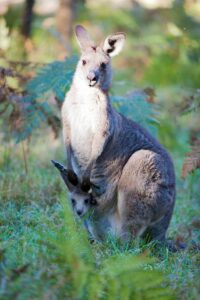What Are Viviparous Animals?
Viviparous animals are animals that give birth to their offspring alive. In other words, they are animals that reproduce via internal fertilization and the resulting embryos develop into fetuses that continue to grow inside the womb of the mother. When the fetuses are fully matured, they are birthed through the birth canal.
The offspring of viviparous animals develop inside an organ called the womb and are supported by another organ called the placenta. The placenta, through the umbilical cord, sustains and supplies all the oxygen and nutrients the embryo needs to develop or grow until it is fully matured and born.
In most cases, viviparous females give birth to fully developed offspring, or at least in an advanced stage of growth, in which the offspring can grow autonomously.
Types of Viviparous Animals
Based on the type of development of the offspring, viviparous animals are classified into three types. They are:
- Placental viviparous Animals
- Marsupial viviparous animals
- Ovoviviparous animals
Placental Viviparous Animals
These are animals whose embryos develop in specialized structures within the womb, such as the human placenta, which adapts to the fetus and widens it so that it can achieve optimal development. Examples of placental viviparous animals are humans, dogs, cats, cows, horses, chimpanzees, and elephants, among others.

Placental viviparity is considered a more evolved gestational system than oviparous (gestation through the laying of eggs). This is because the offspring remains protected from external threats within the mother’s womb, giving it greater opportunities to survive.
Marsupial Viviparous Animals
In the case of marsupial viviparous, the offspring do not culminate their development within the mother’s belly, but in external structures that fulfill a function similar to the placenta for them to develop fully. A classic example of marsupial viviparous is the kangaroo. In addition to kangaroos, koalas, possums, and the Tasmanian devil are also marsupial viviparous.

Ovoviviparous Animals
Here the gestation takes place inside an egg, but this remains inside the mother’s body until its growth phase ends. The egg can hatch inside or outside the mother’s body. For example, the boa constrictor reproduces through eggs that remain inside the mother until hatching. Anacondas, scorpions, Suriname toad, manta rays, platypus, and seahorse are also examples of ovoviviparous animals. In the case of seahorses, it is the males that carry the eggs inside.

Characteristics of Viviparous Animals
In viviparous animals, fertilization takes place internally after the male’s sperm fuses into the female’s egg, forming the zygote.
The offspring develop in specialized structures located in the female’s womb until the time of birth, when they go outside through the birth canal.
The gestation time and the number of young vary according to the species. In humans, for example, gestation lasts 9 months, and most commonly, a single embryo develops. Cases of multiple pregnancies do not occur frequently. In dogs, gestation lasts between 58 and 68 days and an average litter can have between four and six pups.



